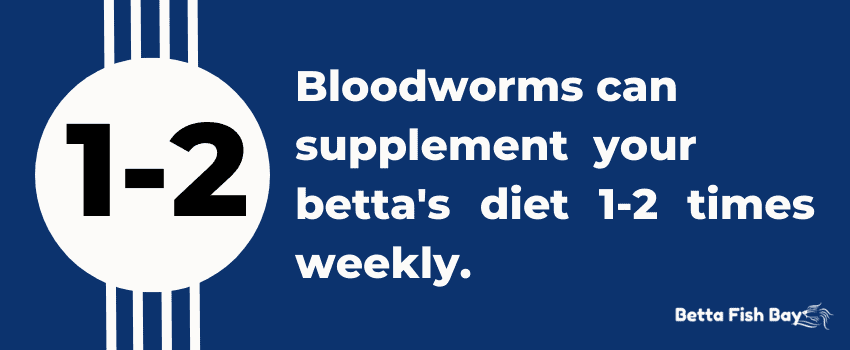A varied diet prevents betta fish from getting bored at mealtime.
You wouldn’t want to eat the same thing every day, so why should your fish?
Supplement your betta’s diet with live, frozen, or freeze-dried foods.
Bloodworms for bettas are popular, but are they safe for your fish?
Bloodworms are safe for betta fish if you feed them in moderation. They are rich in protein, but bloodworms also have a high-fat content. Feeding your betta too many bloodworms may result in obesity, bloating, and constipation.

Table of Contents
What Are Bloodworms?
The type of bloodworm sold in pet stores is not a worm. These bloodworms are midge fly larvae.
Bloodworms get their name because of their bright red bodies. This red color is from hemoglobin, which shows through the exoskeleton.
A bloodworm remains in the larval stage for 2-7 weeks before maturing into a midge fly.
There are visible signs when a bloodworm is about to transition into the pupa stage.
During the larval stage, a bloodworm stays in a “C” shape. As it transitions to the pupa stage, the bloodworm straightens its body.
Not long after the bloodworm enters the pupa stage, it becomes a mature midge fly.
Bloodworms are an excellent choice for bettas and offer several nutritional benefits.
Different Types of Bloodworms for Bettas
There are several forms of bloodworms available for feeding betta fish. Each type of bloodworm has its advantages and disadvantages over the others.
Live Bloodworms
Live bloodworms are the most expensive type but are also a great source of nutrients.
The movement from live bloodworms stimulates your betta’s hunting instincts.
A major disadvantage of bloodworms is their short shelf life.

You may store the bloodworms in the refrigerator for 2-3 days. After this short time, the bloodworms begin transforming into midge flies, and you may no longer feed them to your betta.
Another disadvantage of live bloodworms is their potential to carry parasites or bacteria.
In frozen and freeze-dried bloodworms, parasites and bacteria do not survive.
Frozen Bloodworms
Frozen bloodworms have a much longer shelf life. You may store them in the freezer for up to six months.
Most of the original nutrients remain intact after the freezing process.
There is also a decreased likelihood of diseases, parasites, and bacteria.
The downside to frozen bloodworms is they are messy when feeding to your betta.
Frozen bloodworms come in cubes, and you must break them into smaller pieces. A whole frozen cube contains too many bloodworms for your betta, and most of them go to waste.
You must thaw the frozen bloodworms in a cup of tank water before feeding your betta.
Rinsing the thawed bloodworms in the tank water cup minimizes aquarium contamination risk.
Freeze-Dried Bloodworms
Freeze-dried bloodworms are easy to store and use and have a shelf life of around six months.
These freeze-dried bloodworms have a 55% crude protein content and less fat than live bloodworms.
You only need to soak them in a bit of tank water so they can expand before feeding them to your betta.
They float on the surface instead of sinking immediately, making them easy for your betta to find.
The main disadvantage of freeze-dried bloodworms is their lack of nutrients.
Most essential nutrients in freeze-dried bloodworms do not survive the freeze-drying process.
This freeze-drying process also kills harmful parasites and bacteria.
There are two types of freeze-dried bloodworms: Grade A and Grade B.
Grade A freeze-dried bloodworms are the best ones for your betta fish. These high-quality freeze-dried bloodworms contain fewer foreign particles.
The Grade B bloodworms contain more foreign particles, which may harm your fish.
Are Bloodworms Good for Betta Fish?
Bettas are a carnivorous fish species, so they crave animal proteins.
Bloodworms are an excellent source of protein and iron, but they contain too much fat to be a staple food in a betta fish diet.
They work better as a supplement to your betta’s staple diet 1-2 times per week.

Feeding your betta bloodworms alongside high-quality pellets ensures your fish receives a well-balanced diet.
Bloodworms are an excellent way to add variety to your betta’s diet.
Betta fish are sometimes picky eaters and become bored if fed the same thing all the time.
When your betta becomes bored with its food, it may refuse to eat until you offer something different.
Along with bloodworms, adding baby brine shrimp and daphnia keeps your betta interested during feeding time.
How Many Bloodworms Should I Feed My Betta?
Some betta fish are greedy and eat anything you give them, so offering the correct serving of food is essential.
Only feed your betta 1-2 bloodworms per meal. Feeding too many bloodworms increases the risk of constipation in betta fish.
Reduce your betta’s constipation risk by choosing a fasting day. During fasting, you do not feed your fish for 24 hours.
Fast your betta on the same day every week. A day of fasting gives your betta’s digestive tract time to process the food in the stomach.
Regular fasting keeps your betta’s digestion running smoothly, preventing constipation and other bowel issues.
Never drop an entire cube of frozen bloodworms into your betta tank.
Your betta fish will likely overfeed, and the leftover bloodworms will sink to the bottom of the tank.
As the leftover bloodworms rot, they cause an ammonia spike in your tank.
Ammonia levels higher than zero are unsafe for betta fish. You must perform a partial water change to remove the ammonia and restore your water parameters.
Feeding too many bloodworms at once is also a waste of money. Your betta cannot eat them all, and you must remove the leftovers and dispose of them.
Can Bettas Eat Bloodworms Every Day?
Bloodworms contain too much fat for your betta’s daily diet.
At most, your betta should only eat bloodworms 1-2 times per week, along with high-quality betta fish pellets.
Feeding bloodworms daily leads to an overweight betta fish, bloating, and constipation. Constipation may be fatal without prompt treatment.
The bloating may also cause swim-bladder disease, and your betta will have difficulty swimming.
You increase the risk of introducing parasites or bacteria to your tank by feeding live bloodworms to your betta daily.
Offering your betta a variety of food prevents your fish from becoming bored with its diet and reduces the risk of water contamination.
Ensuring the Bloodworms Are Safe for Your Betta

You must take certain precautions to ensure your betta’s safety when feeding live, frozen, or freeze-dried bloodworms.
Improper storage and feeding techniques may cause health issues in your betta fish.
Follow the Instructions
Freeze-dried bloodworms have instructions on the label on how to feed them to your betta.
These instructions are especially important if you have never fed your betta freeze-dried bloodworms before.
Not preparing the bloodworms properly before feeding could cause digestion issues in your fish.
There may also be warnings on bloodworm packaging about allergic reactions in humans.
It’s rare, but some people have an allergic reaction and break out in a rash after handling bloodworms.
If you discover you are sensitive to bloodworms, do not touch them during preparation and feeding.
Wear rubber gloves or use a spoon to place the bloodworms in the tank.
Buy Bloodworms from a Reputable Source
When buying bloodworms from a pet store or online retailer, research the product for reviews from other fish owners.
If you see many negative reviews, look into buying bloodworms from another company.
Buying bloodworms from a reputable source decreases the chances of contamination from parasites and bacteria.
Once parasites get into your betta tank, it is challenging to remove them.
Store the Bloodworms Properly
Storing your bloodworms correctly is crucial to their shelf life.
You may store live bloodworms in the refrigerator for 2-3 days.
Keep frozen bloodworms in the freezer until you are ready to use them. They will stay fresh in the freezer for up to six months.
Improper storage of bloodworms leads to spoilage and bacteria, which is dangerous for your betta fish.
If you doubt whether your bloodworms are safe to feed to your betta, it is best to throw them out.
You do not want to risk making your betta sick.
How Do You Prepare Bloodworms for Betta Fish?
You must rinse live and frozen bloodworms before placing them in your betta tank.
Rinsing the bloodworms removes harmful bacteria and parasites.
Frozen bloodworms must completely thaw before feeding them to your betta fish.
Place the frozen bloodworms in a cup of tank water and let them thaw for several minutes.
Once the bloodworms have thawed, drain them. Using a spoon, scoop out the bloodworms and place them in the tank.
Take care not to add any of the water from the defrost process. Adding any of this water to your fish tank increases the contamination risk.
Should You Soak Freeze-Dried Bloodworms?
Frozen bloodworms must completely thaw before feeding them to your betta fish.
When freeze-dried bloodworms come into contact with water, they expand to their original size.
Failure to soak the freeze-dried bloodworms means they will expand in your betta’s stomach. This expansion leads to blockages in the digestive tract and constipation.
Constipation is sometimes deadly for a betta fish.
Treat constipation in your fish by feeding your betta boiled peas with the skin removed. Do not feed your fish for 24 hours so the peas have time to move through the digestive tract.
If feeding peas does not resolve your betta’s constipation, place your fish in an Epsom salt bath until it has a bowel movement.
How To Put Bloodworms in Your Aquarium
Once the bloodworms are correctly prepared for your betta, there is no special technique for adding them to the tank.
You may pick them up and drop them in, or use a spoon if you do not want to touch them.
Freeze-dried and frozen bloodworms float on the surface while the live bloodworms will wriggle around.
Watch your betta for a couple of minutes until it finishes the meal. Remove uneaten food right away so the water is not contaminated.
Why Won’t Your Betta Eat Bloodworms?

Not every betta sees bloodworms as a tasty snack, so it is not uncommon for your fish to avoid them.
This is normal behavior for picky eaters and is not a cause for concern.
If your betta is not eating other types of food, this may be a sign of illness or parasites.
Check out our complete list of signs and symptoms of common betta fish diseases and how to help in our article at the link.
Watch your fish for symptoms of illness and test your water parameters.
If your betta seems lethargic or has visible scale damage, these are sure signs of parasites or disease.
Treat your betta for parasites or diseases as soon as possible for a faster recovery.
Can You Breed Bloodworms?
Breeding your own bloodworms is possible. But, if you only have one betta fish, breeding bloodworms is usually not worth the time or expense.
Breeding bloodworms requires a lot of commitment, and you must have adequate space for the setup.
As the bloodworms mature, you must also deal with many midge flies.
Unless you sell bloodworms, breeding them is not likely something you want to do.
It is much easier to buy bloodworms from a reputable supplier whenever you need them.
If you buy bloodworms online, they are shipped right to your door.
Bloody Bloodworms: A Betta’s Favorite Treat
Bloodworms are nutritious and add variety to a bland betta diet.
Bloodworms are among the best snacks for your betta when fed in moderation.
Proper storage and preparation make bloodworms safe for feeding and reduce the risk of parasites and diseases.
For another healthy live food, check out daphnia for betta fish in our article here.


